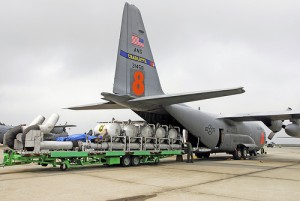 Flying C-130 Hercules aircraft and equipped with roll-on Modular Airborne Fire Fighting Systems (MAFFS) which dispense retardant, U.S. Air Force Reserve and Air National Guard crews have been training around the country to help suppress wildfires this season.
Flying C-130 Hercules aircraft and equipped with roll-on Modular Airborne Fire Fighting Systems (MAFFS) which dispense retardant, U.S. Air Force Reserve and Air National Guard crews have been training around the country to help suppress wildfires this season.
The highly specialized, critical training requires sighting and flying with a Forest Service lead aircraft, flying at the required low altitudes to make the drops effective and dropping water or retardant on a specific area. And, upon return of the aircraft, Forest Service crews receive practice in the quick turn of reloading the MAFFS units.
“These are really experienced pilots, many with thousands of flying hours. But this isn’t the typical mission they’ve flown throughout their careers. They really need to practice and re-certify every year,” said Lt. Col. David Condit, Air Force Reserve chief of aerial firefighting and 731st Airlift Squadron C-130 instructor and evaluator navigator.
The MAFFS program is a joint effort between the U.S. Forest Service and Department of Defense. The U.S. Forest Service owns the MAFFS equipment and supplies the retardant, while the Department of Defense provides the C-130 aircraft, pilots, and maintenance and support personnel to fly the missions.
“The MAFFS are important because they provide a surge capability that can be used to boost wildfire suppression efforts when commercial airtankers are fully committed or not readily available,” said Tom Harbour, director of Fire and Aviation Management for the Forest Service.
Military installations in Wyoming, North Carolina, California, and Colorado provide the C-130s and their crews to fly MAFFS missions: the 153rd Airlift Wing, Wyoming Air National Guard, Cheyenne; the 145th Airlift Wing, North Carolina Air National Guard, Charlotte; the 146th Airlift Wing, California Air National Guard, Port Hueneme; and the 302nd Airlift Wing, Air Force Reserve, Peterson Air Force Base, Colo.
Source: https://blogs.usda.gov/